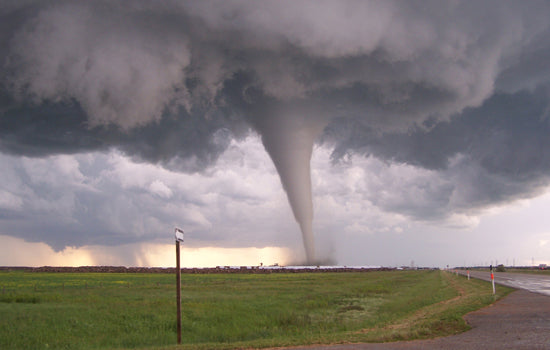
Tornado Safety Tips for Drivers
We recently posted an informal poll on our USCC Facebook page asking what you would do if you were driving in a rural area and a tornado was suddenly heading in your direction.
Answer choices included:
1) Pull over and stay in your vehicle
2) Leave your vehicle and find a ditch to lie down in
3) Step on the gas and try and outrun it
So, what is the right answer? That depends on who you ask. For years, the most popular advice was to leave your vehicle and find a ravine, ditch, or other low-lying area and lie as flat as possible.
The theory behind this is that a car can become a flying missile in a tornado - something you don’t want to be trapped inside. Age-old advice also suggested you never try and out run a tornado. However the American Red Cross has changed their safety advice, suggesting that if you are caught outdoors, with no shelter, you should get into a vehicle, buckle the seat belt, and drive to the closest sturdy shelter.
If debris begins flying while you are driving, you should park the vehicle, keep your seat belt on, put your head below the windows and cover with your hands. You can read the full set of guidelines here: Red Cross Tornado Safety Tips.
Weather.com also advocates staying in a vehicle, but takes its safety tips further by saying you should leave the car running so the airbags will deploy if necessary. You can read the full set of guidelines here: Weather.com Tornado Safety Tips.
The National Oceanic and Atmospheric Administration (NOAA) and National Weather Service (NWS) also acknowledges that while there are few safe options if you’re caught in a car during a tornado, it does suggest that if the tornado is visible in the distance, you may be able to drive out of its path by moving at right angles to the tornado.
You can read the full set of guidelines here: NOAA Tornado Safety Tips. Ultimately, being prepared is your best defense when faced with the possibility of a tornado crossing your path. Stay alert and informed. The NWS will issue a Tornado Watch if conditions are favorable for the development of storms capable of producing tornadoes (this is different from a Tornado Warning, which means a storm has produced a tornado and has been confirmed by site or indicated by radar). The NOAA safety tips also offers these things to look and listen for:
- Strong, persistent rotation in the cloud base.
- Whirling dust or debris on the ground under a cloud base -- tornadoes sometimes have no funnel.
- Hail or heavy rain followed by either dead calm or a fast, intense wind shift. Many tornadoes are wrapped in heavy precipitation and can't be seen.
- Day or night - Loud, continuous roar or rumble, which doesn't fade in a few seconds like thunder.
- Night - Small, bright, blue-green to white flashes at ground level near a thunderstorm (as opposed to silvery lightning up in the clouds). These mean power lines are being snapped by very strong wind, maybe a tornado.
- Night - Persistent lowering from the cloud base, illuminated or silhouetted by lightning -- especially if it is on the ground or there is a blue-green-white power flash underneath
(source: http://www.spc.noaa.gov/faq/tornado/safety.html) Conflicting advice on potentially dangerous situations can be unnerving, but ultimately the right choices will depend on each unique situation.
Tell us: Have you been faced with a tornado while on the road? If so, what advice would you give?


